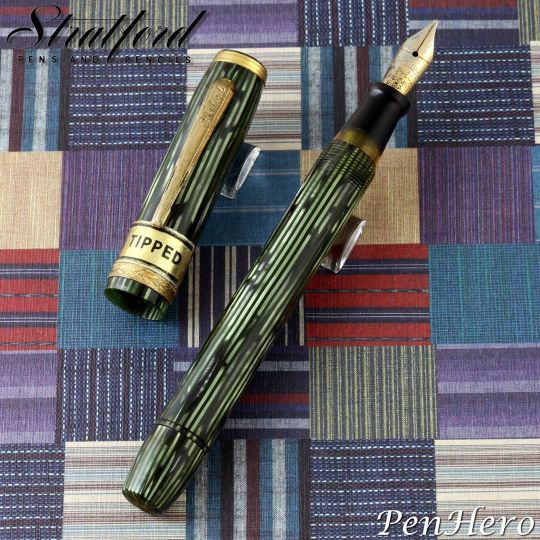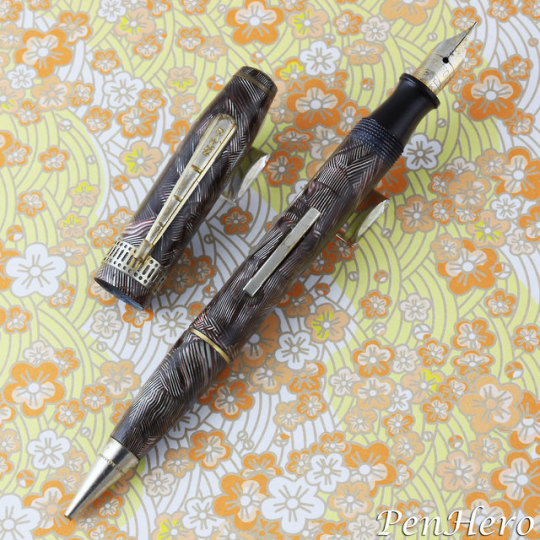#salzbrothers
Text

This is a Stratford fountain pen in emerald green metallic pearl c. 1940. It is very similar to and appears to be the immediate predecessor if not the basis for the the c. 1940-1943 Stratford 77. Advertisements for this pen appear only in 1940. The primary differences are the clip style, cap bands and nib. It's a 4 7/8 inch button fill fountain pen that uses a striped celluloid very similar to the 1st generation Conklin Nozac Penline. The pen fills by removing the blind cap from the end of the barrel, inserting the nib in ink and pressing the button to compress the ink sac and fill the pen. The clip is stamped with the Stratford logo. The cap band has a fletching or arrow feathers design. The cap top band has two thin lines. It features a Lucite ink view section. The trim and the nib were lightly gold plated and shows typical heavy plating loss. The nib is stainless steel and stamped Iridium over TIPPED over MADE IN over U.S.A. The color has faded and the blind cap is brown. The similarity of the celluloid to the Stratford 77 probably means this model was also offered in striped emerald green, silver grey, and golden brown metallic pearl and jet black. It sold for 49 cents in 1940.
7 notes
·
View notes
Photo

This is a Stratford fountain pen in emerald green metallic pearl c. 1940. It is very similar to the c. 1940-1943 Stratford 77. The primary differences are the clip style, cap bands and nib. Stratford was a brand of Salz Brothers Inc. It's a 4 7/8 inch button fill (Salz called it a knob filler) fountain pen that uses a striped celluloid very similar to the 1st generation Conklin Nozac Penline. The pen fills by removing the blind cap from the end of the barrel, inserting the nib in ink and pressing the button to compress the ink sac and fill the pen. The clip is stamped with the Stratford logo. The cap band has a fletching or arrow feathers design. The cap top band has two thin lines. The cap still has the paper band printed with IRIDIUM TIPPED. It features an ink view section made of Lucite. The trim and the nib are lightly gold plated and shows typical plating loss. The nib is stainless steel and stamped Iridium over TIPPED over MADE IN over U.S.A. The similarity to the Stratford 77 probably means this model was offered with the same celluloid cap and barrel in striped emerald green, silver grey, and golden brown metallic pearl and jet black. It sold for 49 cents in 1940. #pencollecting #fountainpen #stratford #salz #salzbrothers #conklin #nozac #penline #penhero https://www.instagram.com/p/B-0JAV1jlRl/?igshid=4bvivwzkik9o
5 notes
·
View notes
Photo

This is a Salz fountain pen and pencil combo in a gray and brown crosshatch celluloid c. 1930s. It's a 5 5/8 inch long lever filler with gold plate trim, though the trim shows heavy plating loss. Salz Brothers was located in New York City and may be best known for making the tiny Peter Pan pens. By the late 1930s the company sold pens under the Stratford name. The clip has the Salz name, though no other markings appear on the pen. This example came with a Stratford 14 karat gold plated stainless steel nib. Stratford was also a Salz brand.
2 notes
·
View notes
Photo

This is a Salz Brothers Peter Pan ringtop fountain pen in what looks like painted blue mottle on black c. late 1920s. It's possible the finish has worn to this state. This 3 3/4 inch long pen features a band of four pairs of large and small flower appliques around the cap. The gold nib is stamped WARRANTED 14K. The lever is stamped SALZ and with the Salz Brothers logo on the tab. The Salz Brothers pen company had been making the tiny Peter Pan pens since about 1916 and continued until at least 1943. The early pens were hard rubber, transitioning to colorful plastics by 1924, based on advertisements. They sold for as little as $1.00 in 1924 and a complementing ribbon sautoir with a "silveroid" slide to fasten the pen was 50 cents. Many colors and decorations were made. The design was significantly changed in the 1930s.
3 notes
·
View notes